Ali Waqar Azim
3GPP-Compliant Radar Cross Section Characterization of Indoor Factory Targets
May 13, 2025Abstract:The following paper presents a systematic 3rd Generation Partnership Project (3GPP)-compliant characterization of radar cross section (RCS) for indoor factory (InF) objects, including small and mid-sized unmanned aerial vehicles (UAVs), robotic arms, and automated guided vehicles (AGVs). Through measurements in the 25-28 GHz range, we validate the 3GPP standardized log-normal distribution model for RCS for above-mentioned target objects. The 3GPP-complaint RCS parameters obtained for the small-sized UAV are in close agreement (<1 dB deviation) with 3GPP agreed values. The mid-sized UAVs exhibit higher reflectivity compared to the small-sized UAV due to enhanced specular components attributed to material and lithium-ion battery packs. The robotic arm exhibits dynamic RCS behavior due to mechanical articulation, whereas UAVs show clear size-dependent reflectivity patterns in AGVs. Our findings provide empirical validation for RCS characterization for integrated sensing and communication channel modeling in InF environments.
Statistical and Deterministic RCS Characterization for ISAC Channel Modeling
Feb 17, 2025Abstract:In this study, we perform a statistical analysis of the radar cross section (RCS) for various test targets in an indoor factory at \(25\)-\(28\) GHz, with the goal of formulating parameters that may be used for target identification and other sensing applications for future wireless systems. The analysis is conducted based on measurements in monostatic and bistatic configurations for bistatic angles of \(20^\circ\), \(40^\circ\), and \(60^\circ\), which are functions of transmitter-receiver (T-R) and target positions, via accurate \(3\)dB beamwidth of \(10^\circ\) in both azimuth and elevation planes. The test targets include unmanned aerial vehicles, an autonomous mobile robot, and a robotic arm. We utilize parametric statistical distributions to fit the measured RCS data. The analysis reveals that the \textit{lognormal and gamma distributions} are effective in modeling the RCS of the test targets over different reflecting points of the target itself, i.e. when target is in motion. Additionally, we provide a framework for evaluating the deterministic bistatic RCS of a rectangular sheet of laminated wood, due to its widespread use in indoor hotspot environments. Novel deterministic and statistical RCS models are evaluated, incorporating dependencies on the bistatic angle, T-R distance (\(2\)m -\(10\)m) and the target. The results demonstrate that some proposed RCS models accurately fit the measured data, highlighting their applicability in bistatic configurations.
Statistical Radar Cross Section Characterization for Indoor Factory Targets
Nov 05, 2024Abstract:In this work, we statistically analyze the radar cross section (RCS) of different test targets present in an indoor factory (InF) scenario specified by 3rd Generation Partnership Project considering bistatic configuration. The test targets that we consider are drones, humans, quadruped robot and a robotic arm. We consider two drones of different sizes and five human subjects for RCS characterization. For the drones, we measure the RCS when they are are flying over a given point and while they are rotating over the same point. For human subjects, we measure the RCS while standing still, sitting still and walking. For quadruped robot and robotic arm, we consider a continuous random motion emulating different tasks which they are supposed to perfom in typical InF scenario. We employ different distributions, such as Normal, Lognormal, Gamma, Rician, Weibull, Rayleigh and Exponential to fit the measurement data. From the statistical analysis, we gather that Lognormal distribution can fit all the considered targets in the InF scenario.
Layered Chirp Spread Spectrum Modulations for LPWANs
May 29, 2024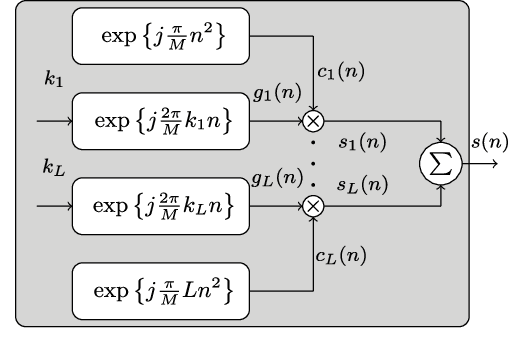
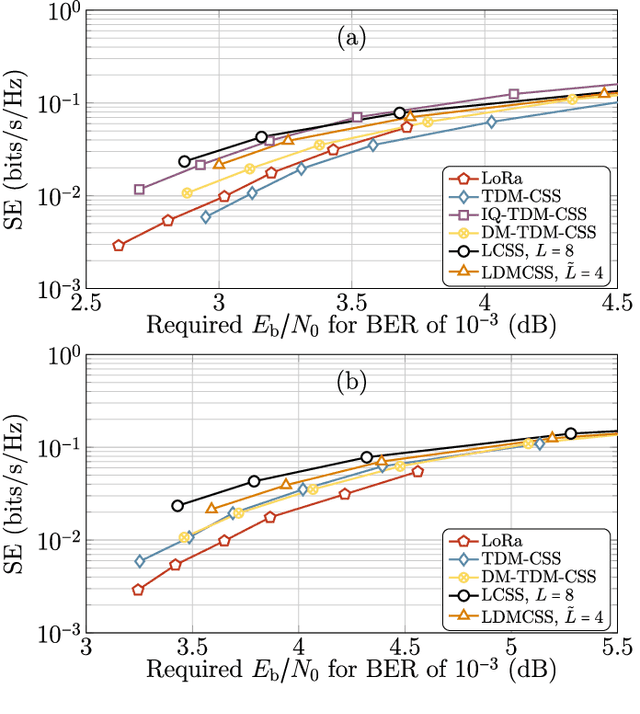
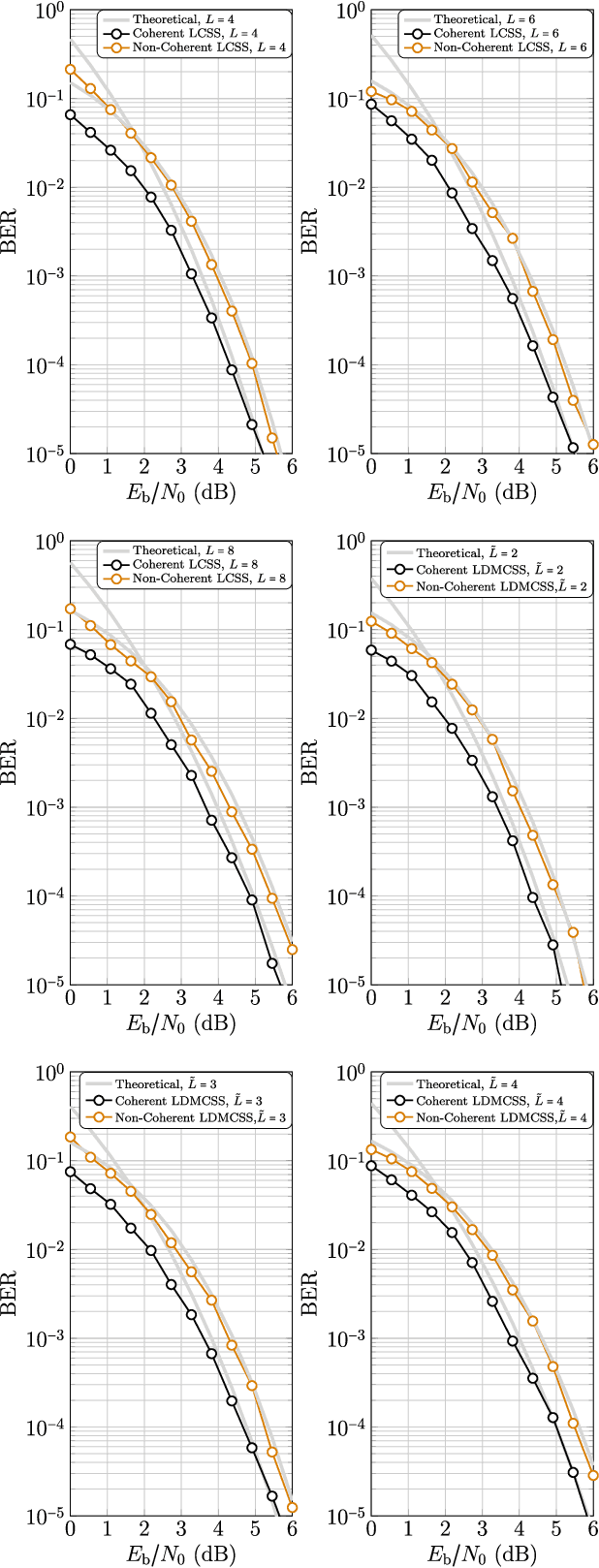
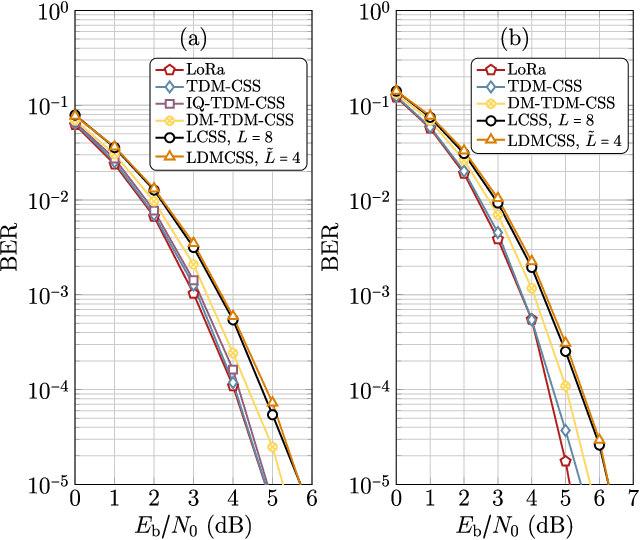
Abstract:This article examines two chirp spread spectrum techniques specifically devised for low-power wide-area networks (LPWANs) to optimize energy and spectral efficiency (SE). These methods referred to as layered CSS (LCSS) and layered dual-mode CSS (LDMCSS), involves utilizing multiple layers for multiplexing symbols with varying chirp rates. These waveform designs exemplify a high degree of SE compared to existing schemes. Additionally, LDMCSS necessitates a lesser number of layers than LCSS to attain comparable SE, thereby reducing computational complexity. These proposed techniques can employ coherent and non-coherent detection and can be adjusted to achieve various spectral efficiencies by altering the number of multiplexed layers. Unlike our proposed LCSS and LDMCSS, other CSS alternatives for LPWANs cannot provide the same level of flexibility and SE. The performance of these techniques is evaluated in terms of bit error rate under different channel conditions, as well as with phase and frequency offsets.
A Unified Deep Transfer Learning Model for Accurate IoT Localization in Diverse Environments
May 16, 2024Abstract:Internet of Things (IoT) is an ever-evolving technological paradigm that is reshaping industries and societies globally. Real-time data collection, analysis, and decision-making facilitated by localization solutions form the foundation for location-based services, enabling them to support critical functions within diverse IoT ecosystems. However, most existing works on localization focus on single environment, resulting in the development of multiple models to support multiple environments. In the context of smart cities, these raise costs and complexity due to the dynamicity of such environments. To address these challenges, this paper presents a unified indoor-outdoor localization solution that leverages transfer learning (TL) schemes to build a single deep learning model. The model accurately predicts the localization of IoT devices in diverse environments. The performance evaluation shows that by adopting an encoder-based TL scheme, we can improve the baseline model by about 17.18% in indoor environments and 9.79% in outdoor environments.
Dual-Mode Time Domain Multiplexed Chirp Spread Spectrum
Oct 08, 2022



Abstract:We propose a dual-mode (DM) time domain multiplexed (TDM) chirp spread spectrum (CSS) modulation for spectral and energy-efficient low-power wide-area networks (LPWANs). DM-CSS modulation that uses both the even and odd cyclic time shifts has been proposed for LPWANs to achieve noteworthy performance improvement over classical counterparts. However, its spectral efficiency (SE) is half of the in-phase and quadrature (IQ)-TDM-CSS scheme that employs IQ components with both up and down chirps, resulting in a SE that is four times relative to Long Range (LoRa) modulation. Nevertheless, the IQ-TDM-CSS scheme only allows coherent detection. Furthermore, it is also sensitive to carrier frequency and phase offsets, making it less practical for low-cost battery-powered LPWANs for Internet-of-Things (IoT) applications. DM-CSS uses either an up-chirp or a down-chirp. DM-TDM-CSS consists of two chirped symbols that are multiplexed in the time domain. One of these symbols consisting of even and odd frequency shifts (FSs) is chirped using an up-chirp. The second chirped symbol also consists of even and odd FSs, but they are chirped using a down-chirp. It shall be demonstrated that DM-TDM-CSS attains a maximum achievable SE close to IQ-TDM-CSS while also allowing both coherent and non-coherent detection. Additionally, unlike IQ-TDM-CSS, DM-TDM-CSS is robust against carrier frequency and phase offsets.
A Survey on Chirp Spread Spectrum-based Waveform Design for IoT
Aug 22, 2022



Abstract:Long Range (LoRa) is one of the most promising and widespread chirp spread spectrum (CSS)-based physical (PHY) layer technique for low-power wide-area networks (LPWANs). Using different spreading factors, LoRa can attain different spectral/energy efficiencies, and can target multitude of Internet-of-Thing (IoT) applications. However, one of the limiting factors for LoRa is the low bit rate. Little to no effort has been made in order to improve the achievable rate of LoRa, until recently, when a number of CSS-based PHY layer LoRa alternative are proposed for LPWANs. In this survey, for the first time, we present a comprehensive waveform design of these CSS-based schemes that have been proposed between 2019 to 2022. In total, fifteen alternatives to LoRa are compared. Other survey articles related to LoRa mostly tackle different issues, such as LoRa networking, LoRa deployment in massive IoT networks, and LoRa architectures, etc. This survey, on the other hand, comprehensively elucidates the waveform design of LoRa alternatives. The CSS schemes studied in this survey are divided into single chirp, multiple chirp, and index modulation based on the multiplexing pattern of the chirps. Complete transceiver architecture of these CSS schemes is studied, and performance is evaluated in terms of energy efficiency (EE), spectral efficiency (SE), bit-error rate (BER) performance in additive white Gaussian noise, BER in the presence of phase and frequency offsets. It has been observed that the EE, SE and robustness against the offsets is primarily linked to transmit symbol frame structure. The public versions of the MATLAB codes for the CSS schemes studied in this survey shall be provided to promote reproducible research.
A Framework for Amalgamating Optical-OFDM and Optical-OFDM with Index Modulation for Optical Wireless Systems
May 20, 2022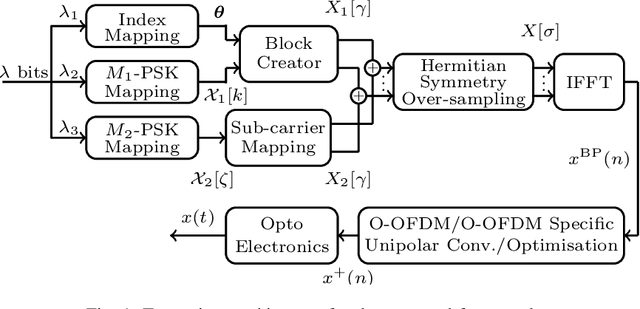
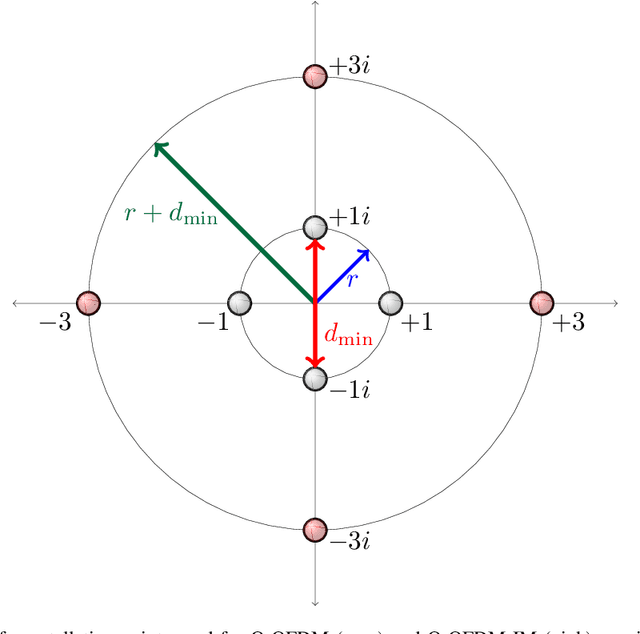
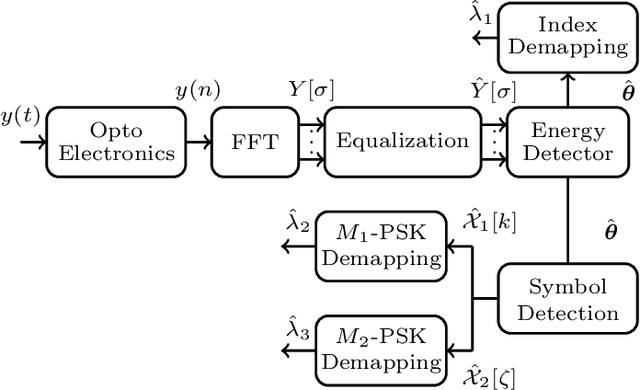
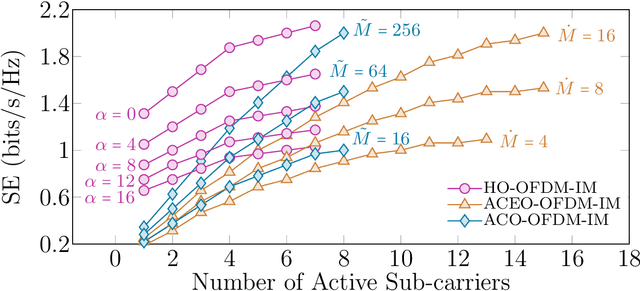
Abstract:In this communication, we propose a framework for amalgamating optical-orthogonal frequency-division multiplexing (O-OFDM) and O-OFDM with index modulation (O-OFDM-IM) for optical wireless systems. Both schemes individually have some limitations, e.g., O-OFDM does not provide any granularity for spectral efficiency (SE)/energy efficiency (EE) trade-off, and O-OFDM-IM loses EE for higher order modulation alphabets. By combining O-OFDM and O-OFDM-IM together, the above limitations can be circumvented. Following on from providing the general framework, we use asymmetrically clipped (AC)O-OFDM and ACO-OFDM-IM to demonstrate the validity of the framework. The results presented herein establish that, by consolidating O-OFDM and O-OFDM-IM, in addition to providing SE/EE trade-off, we may realise higher SE and outperform O-OFDM-IM in terms of EE for high SE.
Dual-Mode Chirp Spread Spectrum Modulation
May 19, 2022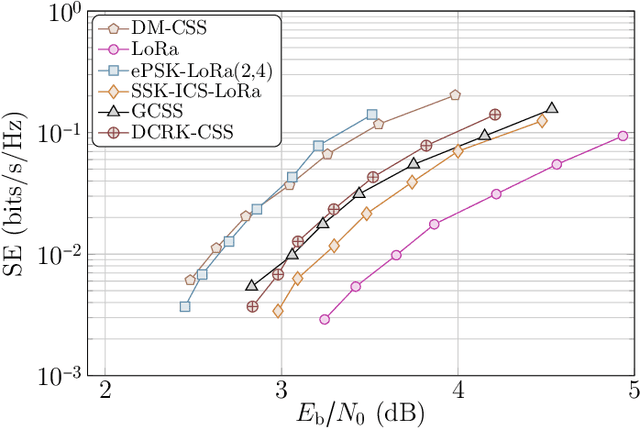
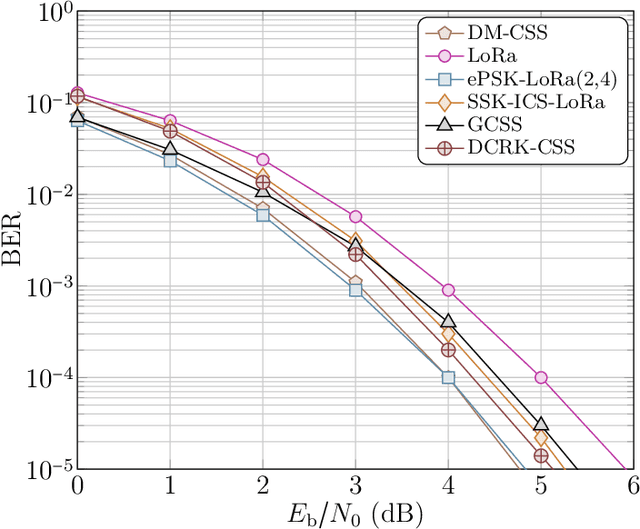
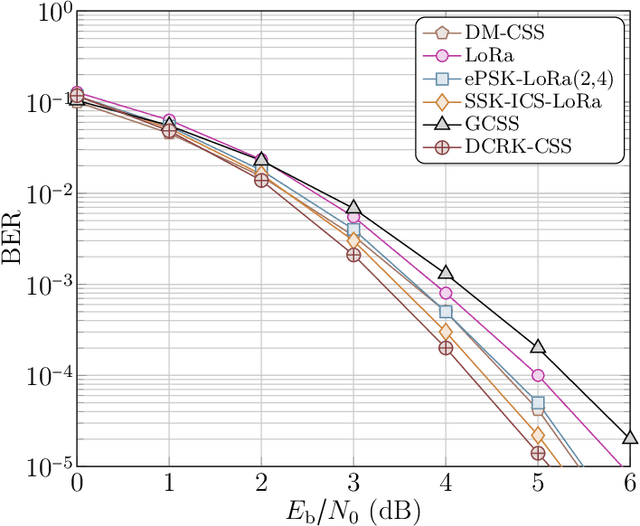
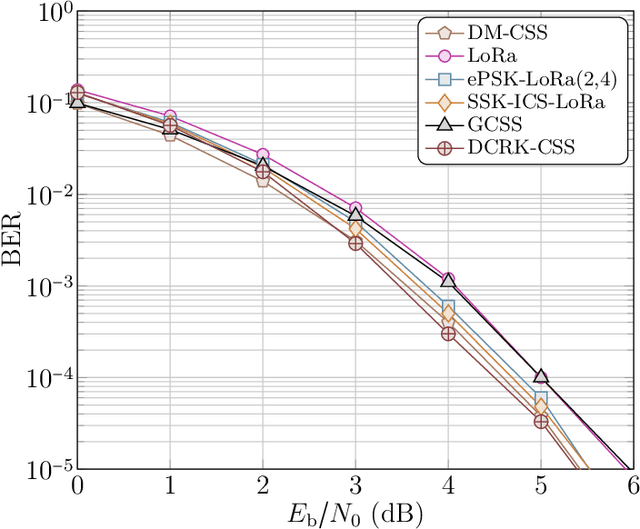
Abstract:In this letter, we propose novel dual-mode chirp spread spectrum (DM-CSS) modulation for low-power wide-area networks for Internet-of-Things applications. DM-CSS is capable of transmitting higher number of bits relative to other counterparts, such as Long Range (LoRa) modulation. Considering the same symbol period, the number of transmitted bits in DM-CSS are augmented by: (i) simultaneously multiplexing even and odd chirp signals; (ii) using phase shifts of \(0\) and \(\pi\) radians for both even and odd chirp signals; and (iii) using either up-chirp or down-chirp signal. Relative to LoRa, the transmitted bit rate increases by up to \(116.66\%\) for the same bandwidth and spreading factor. Moreover, we present a non-coherent receiver architecture for DM-CSS. Simulation results reveal that DM-CSS is not only more spectral efficient but also more energy efficient than most classical counterparts. It is also demonstrated that DM-CSS is robust to phase and frequency offsets.
 Add to Chrome
Add to Chrome Add to Firefox
Add to Firefox Add to Edge
Add to Edge